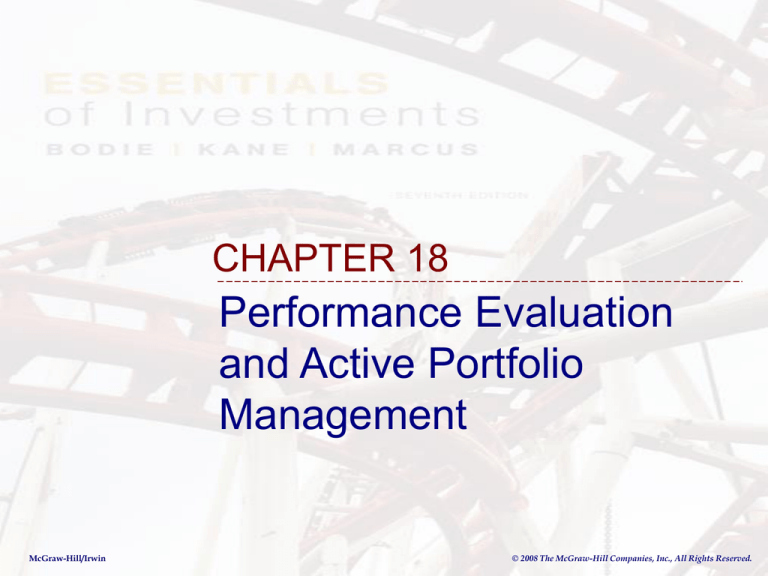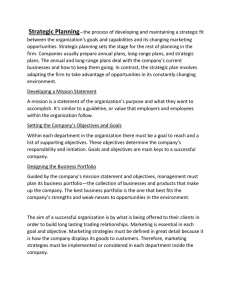
CHAPTER 18
Performance Evaluation
and Active Portfolio
Management
McGraw-Hill/Irwin
© 2008 The McGraw-Hill Companies, Inc., All Rights Reserved.
18.1 RISK-ADJUSTED RETURNS
18-2
Introduction
Complicated subject
Theoretically correct measures are difficult to
construct
Different statistics or measures are appropriate
for different types of investment decisions or
portfolios
Many industry and academic measures are
different
The nature of active managements leads to
measurement problems
18-3
Abnormal Performance
What is abnormal
Abnormal performance is measured:
– Comparison groups
– Market adjusted
– Market model / index model adjusted
– Reward to risk measures such as the Sharpe
Measure:
E (rp-rf) / sp
18-4
Factors That Lead to Abnormal
Performance
Market timing
Superior selection
– Sectors or industries
– Individual companies
18-5
Comparison Groups
Simplest method
Most popular
Compare returns to other funds with
similar investment objectives
18-6
Figure 18.1 Universe Comparison
Periods Ending December 31, 2008
18-7
Risk Adjusted Performance: Sharpe
1) Sharpe Index
rp - rf
sp
rp = Average return on the portfolio
rf = Average risk free rate
=
Standard
deviation
of
portfolio
sp
return
18-8
Risk Adjusted Performance: Treynor
2) Treynor Measure
rp - rf
ßp
rp = Average return on the portfolio
rf = Average risk free rate
ßp = Weighted average b for portfolio
18-9
Risk Adjusted Performance: Jensen
3) Jensen’s Measure
a p = rp - [ rf + ßp ( rm - rf) ]
ap = Alpha for the portfolio
rp = Average return on the portfolio
ßp = Weighted average Beta
rf = Average risk free rate
rm = Avg. return on market index port.
18-10
M2 Measure
Developed by Modigliani and Modigliani
Equates the volatility of the managed
portfolio with the market by creating a
hypothetical portfolio made up of T-bills
and the managed portfolio
If the risk is lower than the market,
leverage is used and the hypothetical
portfolio is compared to the market
18-11
M2 Measure: Example
Managed Portfolio
Market
T-bill
Return
35%
28%
6%
Stan. Dev
42%
30%
0%
Hypothetical Portfolio: Same Risk as Market
30/42 = .714 in P (1-.714) or .286 in T-bills
(.714) (.35) + (.286) (.06) = 26.7%
Since this return is less than the market, the
managed portfolio underperformed
18-12
Figure 18.2 The M2 of Portfolio P
18-13
T2 (Treynor Square) Measure
Used to convert the Treynor Measure into
percentage return basis
Makes it easier to interpret and compare
Equates the beta of the managed portfolio with
the market’s beta of 1 by creating a hypothetical
portfolio made up of T-bills and the managed
portfolio
If the beta is lower than one, leverage is used
and the hypothetical portfolio is compared to the
market
18-14
T2 Example
Port. P.
Risk Prem. (r-rf)
13.00%
Market
10.00%
Beta
0.80
1.0
Alpha
5.00%
0.00%
Treynor Measure
16.25
10.00
Weight to match Market w = bM/bP = 1.0 / 0.8
Adjusted Return RP* = w (RP) = 16.25%
T2P = RP* - RM = 16.25% - 10% = 6.25%
18-15
Figure 18.3 Treynor Square Measure
18-16
Which Measure is Appropriate
It depends on investment assumptions
1) If the portfolio represents the entire
investment for an individual, Sharpe Index
compared to the Sharpe Index for the
market.
2) If many alternatives are possible, use the
Jensen a or the Treynor measure
The Treynor measure is more complete
because it adjusts for risk
18-17
Limitations
Assumptions underlying measures limit
their usefulness
When the portfolio is being actively
managed, basic stability requirements are
not met
Practitioners often use benchmark portfolio
comparisons to measure performance
18-18
Figure 18.4 Portfolio Returns
18-19
18.2 STYLE ANALYSIS
18-20
Style Analysis
Introduced by Bill Sharpe
Explaining percentage returns by
allocation to style
Style Analysis has become popular with
the industry
18-21
Figure 18.5 Fidelity Magellan Fund
Difference: Fund versus Style Benchmark
18-22
Figure 18.6 Fidelity Magellan Fund
Difference: Fund versus S&P 500
18-23
18.3 MORNINGSTAR’S RISK-ADJUSTED
RATING
18-24
Morningstar
Premier source of information on mutual
funds
Risk Adjusted Rating (RAR) among most
widely used performance measures
18-25
Figure 18.7 Average Tracking Error of
636 Mutual Funds, 1985 - 1989
18-26
Morning Star’s Risk Adjusted Rating
Similar to mean Standard Deviation
rankings
Companies are put into peer groups
Stars are assigned
– 1-lowest
– 5-highest
Highly correlated to Sharpe measures
18-27
Figure 18.8 Rankings Based on
Morningstar’s RARs and Excess Return
Sharpe Ratios
18-28
18.4 PERFORMANCE ATTRIBUTION
PROCEDURES
18-29
Performance Attribution
Decomposing overall performance into
components
Components are related to specific
elements of performance
Example components
– Broad Allocation
– Industry
– Security Choice
– Up and Down Markets
18-30
Process of Attributing Performance to
Components
Set up a ‘Benchmark’ or ‘Bogey’
portfolio
– Use indexes for each component
– Use target weight structure
18-31
Process of Attributing Performance to
Components
Calculate the return on the ‘Bogey’ and on
the managed portfolio
Explain the difference in return based on
component weights or selection
Summarize the performance differences
into appropriate categories
18-32
Table 18.5 Performance Attribution
18-33
Table 18.6 Sector Allocation Within
the Equity Market
18-34
Table 18.7 Portfolio Attribution
Summary
18-35
18.5 THE LURE OF ACTIVE
MANAGEMENT
18-36
Lure of Active Management
Are markets totally efficient?
– Some managers outperform the market for extended
periods
– While the abnormal performance may not be too
large, it is too large to be attributed solely to noise
– Evidence of anomalies such as the turn of the year
exist
The evidence suggests that there is some
role for active management
18-37
18. MARKET TIMING
18-38
Market Timing
Adjust the portfolio for movements in the
market
Shift between stocks and money market
instruments or bonds
With perfect ability to forecast behaves like
an option
Little evidence of market timing ability
18-39
Figure 18.9 Rate of Return of a Perfect
Market Timer
18-40
With Imperfect Ability to Forecast
Long horizon to judge the ability
Judge proportions of correct calls
Bull markets and bear market calls
18-41
Market Timing & Performance
Measurement
Adjusting portfolio for up and down
movements in the market
– Low Market Return - low ßeta
– High Market Return - high ßeta
18-42
Figure 18.10 Characteristic Lines
18-43
18.7 SECURITY SELECTION: THE
TREYNOR-BLACK MODEL
18-44
Superior Selection Ability
Concentrate funds in undervalued stocks
or undervalued sectors or industries
Balance funds in an active portfolio and in
a passive portfolio
Active selection will mean some
nonsystematic risk
18-45
Treynor-Black Model
Security analysts can analyze in depth
only a small number of stocks
Market index portfolio is the baseline
portfolio
Macro forecasting unit provides forecasts
of expected rate of return
18-46
Treynor-Black Model:
Characteristics
Objective of security analysis is to form an active
portfolio
– Estimate the SCL
– Determine the expected return
– Use estimates for alpha, beta, and residual risk to
determine optimal weight of each security
Macroeconomic forecasts for passive index
portfolio and composite forecast for the active
portfolio are used to determine the optimal risky
portfolio
18-47
Treynor-Black Model:
Characteristics
Analysis performed using the model can
add value
The model is easy to implement
Lends itself to use with decentralized
decision making
18-48
Portfolio Construction
Rate of return on security i, where ei is the
firm specific component
ri rf bi (rm rf ) ei
18-49
Portfolio Construction
Subset of available securities are researched
and that portfolio will be mixed with the index
portfolio to improve diversification
For each security k, where α represents
abnormal expected return
rk rf b k (rM rf ) ek a k
18-50
Estimating Parameters
For each security analyzed, the following
parameters would be estimated:
a k , b k , s (ek )
2
Active portfolio would have the following
parameters:
a A , b A , s (e A )
2
Total variance would be:
b s s (e A )
2
A
2
M
2
18-51
Sharpe Measurement
Sharpe measurement of the risky portfolio is:
S (M ) a
S ( P)
2
a (e A )
2
2
A
1
2
Position in active portfolio relative to the
market portfolio depends on the ratio of the
active portfolio’s abnormal return relative to its
weakness: appraisal ratio
18-52
Sharpe Measurement
Appraisal Ratio
aA
a (e A )
aA = Alpha for the active portfolio
s(e )= Nonsystematic risk
A
18-53
Summary Points: Treynor-Black Model
Sharpe Measure will increase with added
ability to pick stocks
Slope of CAL>CML
(rp-rf)/sp > (rm-rf)/sp
P is the portfolio that combines the
passively managed portfolio with the
actively managed portfolio
The combined efficient frontier has a
higher return for the same level of risk
18-54
Figure 18.11 The Optimization Process
with Active and Passive Portfolios
18-55






